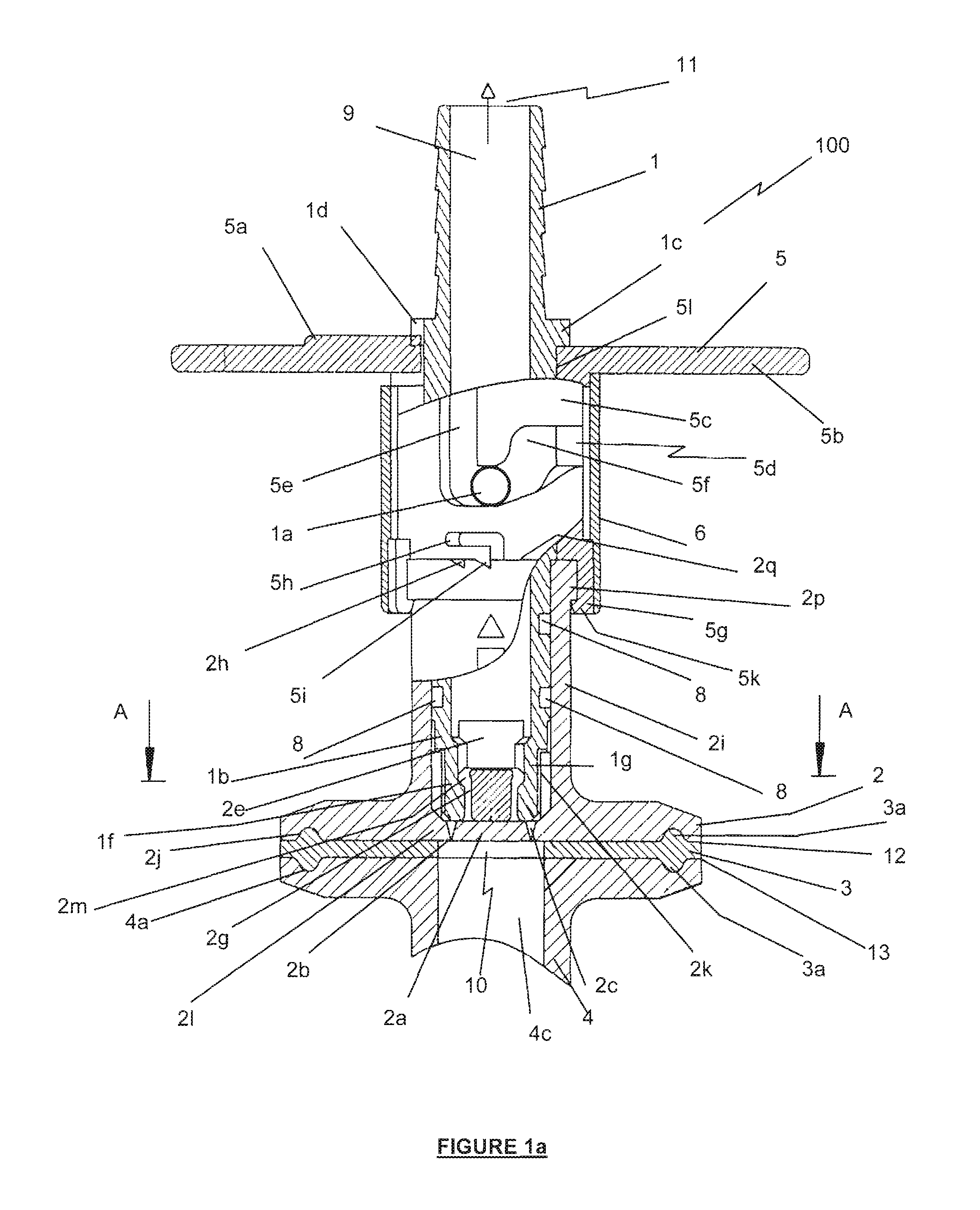Valve
- Summary
- Abstract
- Description
- Claims
- Application Information
AI Technical Summary
Benefits of technology
Problems solved by technology
Method used
Image
Examples
first embodiment
[0068]Referring initially to FIGS. 1a to 1k and FIG. 9, there is shown a single-use valve 100 according to the invention in its closed state. Valve 100 comprises a housing 2 having a bore for receiving a hollow piston 1. Valve 100 has an entry side generally designated 10 and an exit side generally designated 11. At the entry side, housing 2 is connectable to a vessel 4 so that the fluid paths of the opening 4c in vessel 4 and fluid path 9 of the valve 100 are in register. Each of the housing 2 and vessel 4 have corresponding mating surfaces 12, 13, which can be connected together in use in the manner described below. For this purpose, housing 2 is conveniently formed with a sleeve region 2i having at one end an outwardly extending flange 21, the base of the flange 21 comprising the mating surface 12. At its other end, sleeve region 2i is provided with a collar 2p, the end face 2q of which includes notches 2f, 2h, 2d. The purposes of the collar 2p and notches 2f, 2h, 2d will be desc...
second embodiment
[0092]FIGS. 4a and 4b show the valve 200 of the invention. Valve 200 operates as previously described in relation to the first embodiment. In this case valve 200 is coupled to an opening 40c of a separate vessel or pipe 40. The coupling surfaces 212, 413 of both the valve 200 and the opening 40c have a projecting rim 20a and 40a respectively encircling the outer edge of the surfaces. Each surface also has a groove 2j and 4a respectively encircling the circumference of the surface intermediate the seal 2a and the projecting rim. A washer 3 is placed between the two surfaces to provide a seal between them and the washer has complementary ring formations 30a sized and shaped to fit within the grooves in the coupling surfaces.
[0093]FIGS. 5a and 5b are views of a third embodiment of the valve 300 of the invention, which is a modification of the second embodiment. Valve 300 is adapted to connect at its exit side to an opening on a pipe or vessel in similar fashion to the connection at the...
fifth embodiment
[0098]FIGS. 10a, 10b and 10c are a plan view, a side section view and a sectional view of a single use valve 500 according to the invention. Valve 500 operates in the same manner as the previous embodiments of the valve, however the way in which the piston 1 is connected to the seal 2a is different. In this embodiment, the piston 1 and seal 2a are connected by means of a saw-tooth configuration 1c. The saw tooth fit also enables the seal 2a withstand pressures which are a multiple of the normal pressure of a sterilising fluid load without rupturing seal 2a at the junction 2b.
PUM
 Login to View More
Login to View More Abstract
Description
Claims
Application Information
 Login to View More
Login to View More - R&D
- Intellectual Property
- Life Sciences
- Materials
- Tech Scout
- Unparalleled Data Quality
- Higher Quality Content
- 60% Fewer Hallucinations
Browse by: Latest US Patents, China's latest patents, Technical Efficacy Thesaurus, Application Domain, Technology Topic, Popular Technical Reports.
© 2025 PatSnap. All rights reserved.Legal|Privacy policy|Modern Slavery Act Transparency Statement|Sitemap|About US| Contact US: help@patsnap.com



